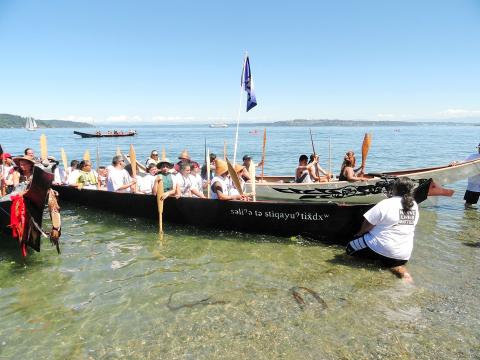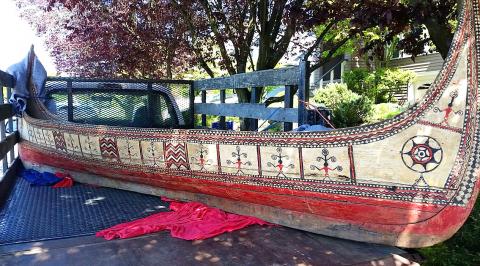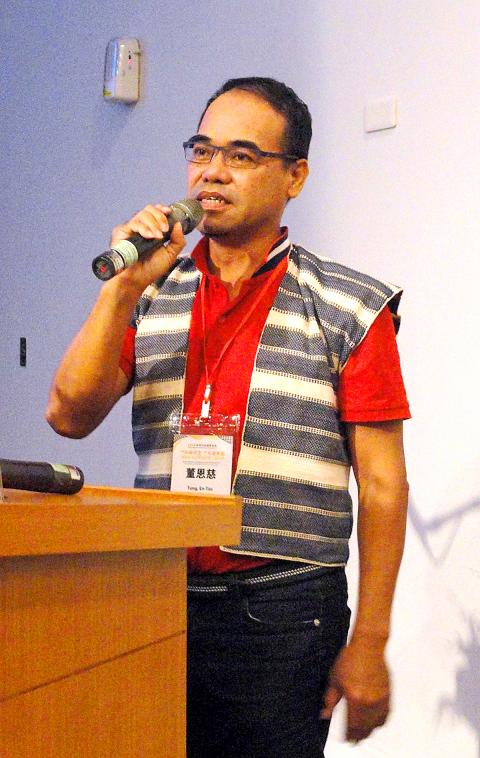The canoe has lost its soul.
For decades the vessel hung from the ceiling of a Seattle salmon restaurant, and is currently in the possession of the city’s Burke Museum, estranged from Taiwan’s Orchid Island and the Tao community that built it.
Syaman Lamuran, a Tao Aborigine, has come to Seattle on a journey of discovery and restoration. He is participating in Tribal Journeys, a three-week trip that began on Monday and will see Native American and First Nation’s communities bring more than 100 traditional and modern canoes up the Pacific West Coast.

Photo courtesy of Gary Smoke
Lamuran will then return to Seattle to determine if the vessel of his ancestors can regain its lost spirit.
CONNECTING COMMUNITIES
Lamuran’s journey is organized and funded by ATAYAL, an American nonprofit that seeks to connect indigenous communities around the world. Gary Smoke, who has lived in Taiwan for 26 years and serves as the organization’s international relations director, says the journey is more of an exploratory trip to initiate contact between Lamuran’s Tao with Native Americans and Canada’s First Nation’s people. Next year, with more time to raise money, Smoke hopes to bring a full Tao crew with a freshly built canoe.

Photo courtesy of Gary Smoke
“It’s a connection between maritime peoples from across the world,” Lamuran says.
ORCHID ISLAND TO SEATTLE
Smoke, a native of the Seattle area, learned about Tribal Journeys while visiting his family last year, when he observed part of the journey and saw similarities between Pacific Northwest canoe culture and that of the Austronesians, who are believed to have spread across Southeast Asia and the Pacific Ocean from Taiwan.

Photo courtesy of Gary Smoke
“I was determined to get some people from Taiwan to join so that we could develop a relationship, exchange cultural ideas, languages and even students,” Smoke says.
Smoke met Lamuran at the International Austronesian Conference in Taipei last November. As chairman of the Tao Foundation (蘭嶼部落文化基金會), Lamuran has been actively promoting and preserving his culture. Smoke says it took a significant amount of time to plan the trip and get a full commitment from the foundation, which left them with six weeks to raise US$8,000.
There aren’t enough funds for Lamuran to bring his own canoe, but he still has a chance to navigate the waters of the Pacific Northwest. Smoke says that due to the large number of participants, canoe families are formed so different groups can take turns “pulling” the canoes, the preferred Native American term, rather than “paddling” or “rowing.” Lamuran met his canoe family on Monday.

Photo courtesy of Michael Jacobson
At the end of each leg, the pullers need to request permission from the host community to come ashore following a specific protocol. After all the canoes arrive, a feast commences with dancing and singing.
WANDERING CANOE
Lamuran says he hopes to learn about how other indigenous people deal with drastic environmental changes and various social issues. He’s also interested in intratribal relationships as well as how they deal with outsiders and mainstream culture.

Photo courtesy of Gary Smoke
“I hope that more people learn about Taiwan’s maritime culture and learn that [Taiwan’s inhabitants] are more than just Han Chinese,” he says.
After the journey, Lamuran’s group will head to the museum, located on the University of Washington campus, on July 27 to visit the Tao canoe. They will meet with curators and local Native American groups to discuss the vessel and other indigenous issues.
The canoe was first brought to the US in the 1970s by late restaurateur Ivar Haglund, who obtained it during a trip to Taiwan to buy Chinese-style furniture for his property. Haglund kept it in his Ivar’s Indian Salmon House, since renamed Ivar’s Salmon House, and, during a renovation in the 1990s, removed all the non-Pacific Northwest artifacts.
The canoe was moved to a warehouse where it languished until local collector and former Taiwan resident Michael Jacobson bought it, along with other Aboriginal artifacts, in 2015. He then donated the canoe to the museum.
Lamuran says the canoe needs a soul because it has been separated from its homeland for so long.
“It’s a real shame,” he says. “It doesn’t matter why the canoe left its home, it was built by the hands of my ancestors and the wood from our island. I hope that in the future I can bring an elder [to the museum] to perform a ritual so as to restore its soul.”
For more information, visit: www.atayal.org

Many people noticed the flood of pro-China propaganda across a number of venues in recent weeks that looks like a coordinated assault on US Taiwan policy. It does look like an effort intended to influence the US before the meeting between US President Donald Trump and Chinese dictator Xi Jinping (習近平) over the weekend. Jennifer Kavanagh’s piece in the New York Times in September appears to be the opening strike of the current campaign. She followed up last week in the Lowy Interpreter, blaming the US for causing the PRC to escalate in the Philippines and Taiwan, saying that as

US President Donald Trump may have hoped for an impromptu talk with his old friend Kim Jong-un during a recent trip to Asia, but analysts say the increasingly emboldened North Korean despot had few good reasons to join the photo-op. Trump sent repeated overtures to Kim during his barnstorming tour of Asia, saying he was “100 percent” open to a meeting and even bucking decades of US policy by conceding that North Korea was “sort of a nuclear power.” But Pyongyang kept mum on the invitation, instead firing off missiles and sending its foreign minister to Russia and Belarus, with whom it

The Chinese Communist Party (CCP) has a dystopian, radical and dangerous conception of itself. Few are aware of this very fundamental difference between how they view power and how the rest of the world does. Even those of us who have lived in China sometimes fall back into the trap of viewing it through the lens of the power relationships common throughout the rest of the world, instead of understanding the CCP as it conceives of itself. Broadly speaking, the concepts of the people, race, culture, civilization, nation, government and religion are separate, though often overlapping and intertwined. A government

Nov. 3 to Nov. 9 In 1925, 18-year-old Huang Chin-chuan (黃金川) penned the following words: “When will the day of women’s equal rights arrive, so that my talents won’t drift away in the eastern stream?” These were the closing lines to her poem “Female Student” (女學生), which expressed her unwillingness to be confined to traditional female roles and her desire to study and explore the world. Born to a wealthy family on Nov. 5, 1907, Huang was able to study in Japan — a rare privilege for women in her time — and even made a name for herself in the